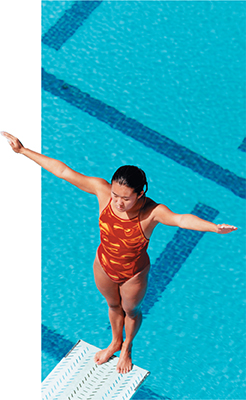Gravitational Potential Energy
When you lift your gym bag up to the top seat of the bleachers, you do work to increase the potential energy of your bag. Potential energy that depends upon an object's height is called gravitational potential energy. This type of potential energy increases when an object is raised to a higher level.
The diver shown in Figure 4 is standing motionless at the end of a diving board, so she has no kinetic energy. But she does have energy—gravitational potential energy. She gained this potential energy by doing work—by climbing up the steps to the diving board. As always, the work done equals force (her weight) multiplied by distance (the height she climbs). You can use this work to calculate how much potential energy is gained.
 An object's gravitational potential energy depends on its mass, its height, and the acceleration due to gravity. The gravitational potential energy an object gains is equal to its weight (mg) multiplied by its height (h).
An object's gravitational potential energy depends on its mass, its height, and the acceleration due to gravity. The gravitational potential energy an object gains is equal to its weight (mg) multiplied by its height (h).
Gravitational Potential Energy
Potential energy (PE) = mgh
To calculate gravitational potential energy in joules, the mass of the object is expressed in kilograms and the height of the object is expressed in meters. The acceleration due to gravity, g, has a value in SI units of 9.8 m/s2 on Earth. Note that height is measured from the ground or floor or some other reference level. Therefore, gravitational potential energy is measured relative to that same reference level.
Gravitational potential energy is directly related to the mass of the object and its height relative to a reference level. Thus, doubling either the mass of the object or its height doubles its gravitational potential energy.
Suppose the diver at the top of a 10.0-meter-high diving platform has a mass of 50.0 kilograms. You can calculate her potential energy relative to the ground as follows.
If, instead, the diver was standing on the ground, her height above the ground would be zero. Therefore, her gravitational potential energy relative to the ground would also be zero.

What is gravitational potential energy?
Figure 4 This diver has gravitational potential energy as she stands at the end of a diving board. Predicting How would the diver's potential energy change if she stood on a platform twice as high as the one shown in the photo?






